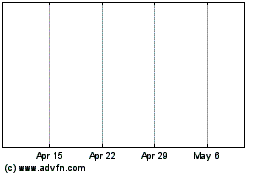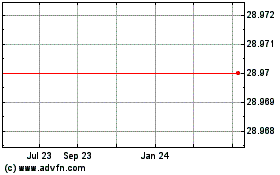Q&A: Australian Gas Producer Woodside Seeks a Role on Global Stage
27 August 2021 - 4:08PM
Dow Jones News
By Rhiannon Hoyle
Australia's Woodside Petroleum Ltd. this month agreed an
all-stock deal to buy the oil-and-gas business of BHP Group Ltd.,
the world's largest mining company, which the companies said would
create one of the world's top-10 independent energy companies by
production.
Combining the businesses into what would also become the largest
energy company on Australia's stock exchange would give Woodside a
stronger cash flow and fiscal strength to fund both planned
developments and investment in new energy markets, according to
newly appointed Woodside CEO Meg O'Neill.
Ms. O'Neill spoke with The Wall Street Journal about what the
deal means for Woodside's exposure to liquefied natural gas,
potential ESG risks and future rehabilitation obligations. Here are
edited excerpts:
Q: What feedback have you received from shareholders on the
proposed deal?
A: Our investors and shareholders are very excited. They
recognize the strategic rationale for the deal. They recognize that
the merger gives us a geographically diverse and very well balanced
portfolio of options and creates significant growth optionality.
Investors are particularly excited about what it does for us
financially. The balance sheet will be in very strong shape with
the BHP petroleum business coming across with no debt. Cash flow
will be bolstered--doubled versus what Woodside's forecasts alone
would have been, which gives us the financial strength to not just
fund our planned development in both the hydrocarbon and low-carbon
opportunities, but also to return value to our shareholders
throughout the cycle.
Q: What about concerns from some shareholders that it will
dilute Woodside's LNG exposure?
A: Investors are very keen to understand our product mix. I
think what's interesting to note is that when the merger proceeds
we will still be 70% gas: we will be about 50% LNG, the rest will
be a pipeline gas position. So, in terms of the way that we support
our customers in decarbonizing, we will remain a very gas-oriented
business which I think is quite exciting for our investors.
Q: Does this deal raise the ESG risks Woodside might face by
increasing its exposure to fossil fuels?
A: One thing I think Woodside's investors should be quite
pleased with is all of Woodside's commitments as it pertains to
climate change and decarbonization will be applied to the entire
portfolio. So we are firmly committed to transparently reporting
our equity emissions, operated and not operated. We've made
commitments to reduce our net emissions: reducing net emissions 15%
by 2025, 30% by 2030, with an aspiration of net zero by 2050. Those
commitments will be applied to the entire portfolio. So I think the
strength of our commitments to decarbonization is something that
investors should take great heart in.
Q: Do you expect the oil and gas sector to face increasing
pressure from activists to address climate change?
A: We recognize that climate change is one of the most
significant issues facing our planet today. We also fully
appreciate that as an energy company we have a particularly
important role to play, which is why we do have strong
decarbonization commitments for our own business. One of the things
that I think will be a great opportunity for us going forward, that
will help demonstrate our commitments to a lower carbon future, is
the work that we're doing looking at investment in lower-carbon
energy, such as hydrogen and ammonia. And we're working today, in a
number of consortia and partnerships with prospective customers of
those products, to progress a pathway where we will be able to make
those investments.
Q: If the deal with BHP goes ahead, there will likely be some
BHP shareholders that want to sell their allocated stock in
Woodside. Are you concerned about the prospect of an exodus?
A: We have carefully reviewed the BHP shareholder register. When
we look at the aggregate shareholdings in BHP and compare it to
Woodside shareholders, we think there will be demand for Woodside
shares that outpace the supply that's available from those BHP
shareholders that don't want to stay with us. So, at the end of the
day, we think the balance will work out favorably. But we do
recognize there will be a bit of uncertainty, particularly as BHP
progresses with their unification ahead of this merger being
concluded.
Q: What is your response to concerns from environmental groups
over how Woodside will handle the rehabilitation of BHP assets?
A: We fully accept that as part of a responsible development of
offshore resources one key step is remediation. I think we have
very strong credentials. We routinely plug in abandoned wells that
are no longer flowing, and so we understand the obligations. The
obligations have been accounted for in the valuation that we've
applied to the merger. We look forward to closely working with the
operator, particularly in Bass Strait on detailing those plans and
getting after the work.
Write to Rhiannon Hoyle at rhiannon.hoyle@wsj.com
(END) Dow Jones Newswires
August 27, 2021 02:05 ET (06:05 GMT)
Copyright (c) 2021 Dow Jones & Company, Inc.
Woodside Petroleum (ASX:WPL)
Historical Stock Chart
From Mar 2024 to Apr 2024

Woodside Petroleum (ASX:WPL)
Historical Stock Chart
From Apr 2023 to Apr 2024
